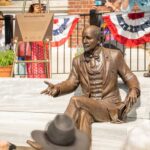The Jazz Urbane Cultural Commentary
I see culture as fluid and history as an expanding people map, moving through interaction and the creation of rituals and customs to mark a civilization’s expanding territories in time. I’m interested in the dynamics of those conversations, expressions, meanings and the arts’ representations of these interactions.
I’m interested in the relationship, linkages in historical origins and contemporary expression.
A social analysis has to ask; What happened in the Harlem Renaissance, civil rights periods, hip-hop, Seattle grunge movements and when, how and why did people move to and through these periods?
What music, art, social and cultural questions were wrestled with to live and be a creative human in these well marked times? How did we evolve here? What lessons have been learned and how do these inform and impact us? Somewhere in all this is the scream, the beat and the lyrical poem, dance, paint and sing-lines from the soul. I want to hear and feel and try and understand and appreciate what that is now, again, then again and then some more.
In “The Autobiography of Leroi Jones,” Amiri Baraka said, “…the people have no music, that is in coordination with their spirits … because of this they are out of tune with the were going.. they are the harbingers, reflectors of the same life development … We followed Trane … our own teaching for new definition. We heard our own search, travails, our reaching for new definitions. Trane was our flag. But, there were other, younger forces, and this added other elements to the music (Ornette, Cecil, Oliver Nelson, Eric Dolphy. There was a newness, defiance …laid out in their music … politically and creatively, it was all connected. It was as if the music was leading us.”
This pool of inquiry allows us to bring to the new game cultural table all kinds of expressions (music, poetry, film, media studies), experiences and narratives to that talking table to interrogate, enjoy and learn from.
When we apply these questions to a song lyric or a political/spiritual position, we inspire and raise the knowledge level of human interaction and understanding.
In a progressive Black lexicon, our more complete set of meaningful sentiments in our new language, and branches of knowledge evolving here in “our story,” we will find life greatly sculpted into a movement of personalities, ideas, hearts, values, spirit, science and innovations in literature and the arts.
Black American music and social/political spirit-infused thinking and artistry in the 20th/21st century, in all its forms, became one of the most revolutionary forces of human expression that most deeply affected, influenced and impacted the world.
So the story of music, poetry, literature, dance and paint, becomes the expression of people and a transport of cultural heritages of immense power and value. The very existence and definitions of identity, reside there in the music and other cultural expressions of relevance.
In an essay from “Wicked Theory, Naked Practice,” Fred Ho said, “… (music) social role as protest, resistance, musical energy, revolutionary aesthetic qualities … social history of rebellion, revolt, musical defiance to … challenge, contest … co-opted, diluted, eviscerated commercialized forms … revolutionary … not just for America, but for the planet … (a music in which) every major innovation … has been from musicians to attain greater and greater levels of expressive freedom through liberating the two basic fundamentals of music: time and sound … and the African blurring … to reach an emotive and spiritual catharsis to allow the gods (wisdom) to descend to affirm personal and communal humanity in the face of inhumanity.”
To make connections to these ideas in discussions is how we are to make the bridge through creativity, maintain cultural relevance and imbue this generation with opportunities, approaches and sustainable skill sets to keep the music and arts, contemporary actions and ideologues moving beyond.
I think there is an overload in the preset/easy-access marketed media-minded culture ecosystem. In order for Black progressive culture to survive, it needs an equal distribution of thoughtful, informed social/cultural/political “creatives” providing nutrients, wisdom seed distributors, teachers and business infrastructure builders.
Because today, the cultures we produce in have no more oxygen. They are oversaturated and can’t produce enough substantive, transformative input.
It needs to be equally rebooted with venues, a more equitable share of profits and a clearer commitment to core values not based on getting attention and money.
In the introduction of the 1964 edition of “Shadow and Act,” Ralph Ellison said:
“We were seeing examples to live by, out of freedom which for all it’s being ignored by the sociologists and subtle thinkers was implicit in the Negro situation. Father and mother substitutes also have a role to play in aiding the child to help create himself. Thus we fabricated our own heroes and ideals catch as catch can, and with an outrageous and irreverent sense of freedom…Gamblers and scholars, jazz musicians and scientists, Negro cowboys and soldiers from the Spanish American War and First World Wars, movie stars and stuntmen, figures from the Italian Renaissance and literature, both classical and popular were combined with the special virtues of some kind of bootlegger, the eloquence of some Negro preacher … we felt to develop ourselves for the performance of many and diverse roles … not only were we to prepare but we were to perform with, may we say Negro American style … Behind each artist there stands a traditional sense of style … a yearning to make everything of quality Negro American; to appropriate it, possess it, re-create it in our own group and individual images.”
It’s important to remember that the main thing is to expose younger people to great examples, models of achievement, and how culture, just a few years ago, mattered and transformed the world. So by helping them to be aware and knowledgeable of how important all this is to their identity and perspectives, and how it contributes to a larger social engagement.
Today, the mainstream media cultural frameworks do not have many examples of excellence, especially in popularly placed artistry, like Woody Guthrie to John Coltrane, Mary Lou Williams, Nina Simone, Bob Marley, Jill Scott up to Kendrick Lamar, Esperanza Spalding, Beyonce. These are people who are passionately committed to a consciousness of excellence and what that costs and means, with “no zero glo” compromises.
True, full cultural education must focus on fostering a committed work ethic(s) based on social, political and cultural excellence at every level.
We must be committed to this as performers, producers, conceptualists, teachers, as historians of the trade, in the business of arts industries and most importantly in the real meaning of arts/ education, to lift people and transform the world we live in.
All great art is about the power to move toward human truths, universal ideals that reflect balance, order, beauty, love, justice and inspiring ideas that change people’s lives.
In “The Crisis Of The Negro Intellectual,” Harold Cruse wrote, “… it remains for the Negro intellectual to create his own philosophy and to bring the facts of the cultural history in focus with the cultural practices of the present. In advanced societies, it is not race politicians or the rights leaders who create the new ideas and the new images of life and man. That role belongs to the artists and intellectuals of each generation.”
This is the most important set of educational values that should guide us in developing and sharing with this generation, to dismantle the current dismantling of our minds, hearts and souls.






